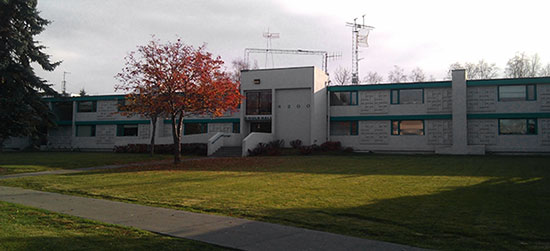APU’s Gould Hall was named for our founder Peter Gould, an Aleut Methodist minister, whose vision was that Alaskans and Alaska Native people deserved access to an outstanding private liberal arts education. APU continues to serve his vision to this day. Originally Gould Hall served as the campus dormitory. It survived the 1964 earthquake. The United States Geological Survey, located on the APU campus, leased Gould for several years but relocated in 2012 to the recently completed addition to Glenn Olds Hall, adjacent to Gould.
APU is renovating the ground floor and half of the second floor of Gould Hall to accommodate the growth of student and faculty applied and field research projects in environmental science (ES), marine biology, and outdoor studies (OS). Together, these three programs attract more than a third of APU’s traditional undergraduate student body. The Master of Science in Environmental Science (MSES) is the second largest graduate program. Over the past decade APU’s science programs have roughly doubled in size, in both faculty and students. The ES department added a major in earth science and a fisheries program, and OS now has a graduate program. Greater emphasis is placed on student-faculty research in senior projects and graduate theses, as well as in courses that emphasize project-based learning.
The Gould Hall renovation allows students and faculty ready-access to laboratory space and computers to conduct field research and long-term experiments. The ground floor space is particularly suited for ES and OS programs that conduct field-based and laboratory testing. It provides ample storage of, and easy access, to field based gear and equipment.
In July 2013 APU secured a $500,000 Rasmuson matching grant for the Gould Hall renovation and will submit a Murdock Foundation grant application in October. The two grants combined will enable us to complete the Gould Hall basement building code and safety requirements, HVAC system improvements, the Physical Science Teaching Lab, Outdoor Studies office and gear room, student research project spaces, and the student lounge space. The Murdock Foundation Board meets in November.
In the meantime, several ES faculty (Leslie Cornick, Brad Harris, Amanda Booth, Jason Geck, Michael Loso and Roman Dial) have moved their offices into Gould. Brad’s Applied Fisheries Research Lab and Leslie’s Marine Physiological Ecology Lab moved into Gould in fall 2012, and Roman has collaborator and student office space for an ecology project partnering with Joint Base Elmendorf Richardson. Dr. Cornick, Chair of the ES Department, took the lead on planning the Gould space usage and preparing the grant applications and was one of the first APU faculty members to move into Gould. ”When we first proposed the move to Gould some folks were reluctant because it felt somewhat removed from other department offices, but the energy and collaboration and creativity that has developed in Gould over the last year has been very exciting and it has become the “hot spot” on campus for the sciences, with graduate students, undergraduate students and faculty working on cutting edge and real-world projects. I’ve never seen so much activity on a campus during the summer!”
APU’s Psychology department faculty are exploring possibilities to establish a “Teaching Clinic” on the top floor of Gould Hall, open to the University and the larger Anchorage and Alaskan community, to serve the curriculum and training needs for students in its Master’s and Doctoral programs, establish suitable practicum and internship opportunities for students in APU’s Doctor of Psychology program, and serve behavioral health needs within the Anchorage community while generating an income stream to support the program.
Kellogg Farm Master Plan
The Rasmuson Foundation’s 2012 commissioned research paper-Food Security and Local Food Production in Alaska states its intent-to “inform potential future development and support initiatives designed to stimulate the expansion of local food options in Alaska and promote overall food security within our state.” Their findings included:
- Alaska imports 95% of its food and has just three days worth of food available on store shelves
- USDA ranks Alaska last compared to other states in agricultural production
- An integrated food system, in which food is primarily grown locally and the money used to purchase products that stay in the state, currently does not exist in Alaska
- Limitations to farming in Alaska include lack of capital for farm investment, capacity constraints, lack of distribution systems for moving food into mainstream markets; and limited research, formal and informal education, and training programs for marketing local foods
Alaska Pacific University (APU) is well positioned to address these findings and intends to utilize its 700 acre Spring Creek farm in Palmer, bequeathed from Alaska pioneer Louise Kellogg and drawing upon her vision, collaborate with Alaska pioneers Tim and Lisa Meyers of Bethel to 1) incorporate, build upon, and extend the techniques Tim and Lisa have experimented with, 2) create learning laboratories at both the Meyers and Kellogg farms to hone these techniques, 3) educate Alaskans in the use of them, and 4) increase the production of locally grown, nutritious foods throughout Alaska.
In order to best utilize the Kellogg Farm over the long term and provide a blueprint for its subsequent development, we secured two $25,000 grants (Rasmuson and BP) and retained Rim Architects to prepare a Kellogg Master Plan, now in progress. We are applying for other grants with a goal to complete the Master Plan by early spring. Part of that work involves the development of a plan to construct a demonstration garden and a moveable high tunnel adjacent to the Atwood dorms on the APU campus along with the creation of a seed germination area (utilizing the boiler room heat) and a dry food storage area (root cellar) in space available in the Atwood basement.

